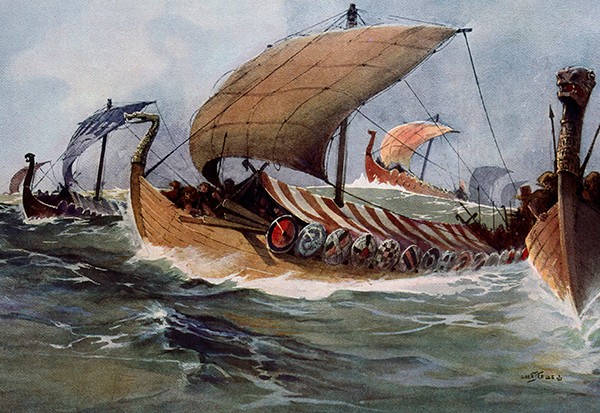I’d like to begin this month’s archaeology post by discussing one error that is often made about the fierce warriors who spread out from Scandinavia in their longships wreaking havoc throughout Europe during the Dark Ages. There is actually almost no evidence that they called themselves Vikings. Indeed, from the few records of those dark years it seems more like they referred to their raids as to ‘go Viking’. In others words Viking was an activity, not a name for themselves. The name they seemed to prefer, and by which their enemies called them was Northmen, Norsemen or just Norse.

Another big question is just what is the relationship between the ship borne Northmen of the 9th-12th centuries and the Germanic ‘Barbarians’ of the 5th-8th centuries who overran the Roman Empire. Their languages were similar, modern German, Norwegian and Swedish are all part of the Germanic group of the Indo-European languages. They were all best known as warriors and they all contributed to making the ‘Dark Ages’ Dark!

Such questions can only be answered by more evidence and so this month I’ll be covering some of the latest archaeology finds concerning the Northmen. In fact the first find deals directly with the question of the relationship between Germans – Northmen as it contains elements characteristic of both groups.

Despite it’s small size the nation of Denmark has played a central role in both the Germanic invasions of the Roman Empire and the later Norse invasions of Christian Europe. Now a new discovery of a buried hoard of gold objects in the small Danish town of Vindelev highlights that key role. The buried treasure was unearthed, not by a professional archaeologist but rather by an amateur metal detectorist. In fact the detectorist, Ole Ginnerup Schytz found his treasure on an old friend’s land after only a few hours of using his brand new metal detector.

The hoard has been officially been named the ‘Vindelev Hoard’ and contains several dozen items totaling nearly a kilogram of solid gold which have been dated to the 6th century CE. The items range from large, saucer like medallions called bracteates to pieces of jewelry to coins from the Roman Empire.

One of the bracteates is particularly interesting as it shows the figure of a man with braided hair surrounded by images of a horse, a bird and another man. There are also runes on the surface that may spell out the word ‘houar’ meaning ‘high one’. Both the title and images could refer to the Norse god Odin and could be some of the earliest evidence for the worship of that pagan god who was best known from the 9th-11th century.

The site where the hoard was unearthed was later surveyed by archaeologists from the Vejle Museum who found that the treasure was actually buried inside a longhouse, a structure typical of both the Germans and the later Norse. The size of the house and the value of the hoard have suggested to some archaeologists that Vindelev may have been an important cultural site back in the 6th century.
If the Vindelev hoard tells us something about the connection between the Germans of the late Roman Empire and the early Norse another site, from 500 years later and thousands of kilometers distance may tell us the exact date when the Norse attempted to colonize North America. The evidence comes from the only agreed upon Norse site in the New World, an archaeological settlement in Newfoundland called L’Anse aux Meadows.

What the team of scientists, led by Margot Kuitems and Michael Dee of the University of Groningen in the Netherlands have recovered are four pieces of wood that show clear signs of having been cut by metal tools, which the local Native Americans did not possess. Those samples of wood were then subjected to a special type of carbon-14 dating test.

Carbon-14 dating is possible because cosmic ray particles striking the upper atmosphere convert nitrogen atoms into the radioactive isotope carbon-14; the stable isotope of carbon is carbon-12. A small amount of this radioactive carbon is absorbed by plants, which then makes the plants slightly radioactive.

Once the plant dies it no longer absorbs carbon and the carbon-14 that it did absorb begins to decay with a halflife of 5730 years. By comparing the amount of carbon-14 in a long dead plant to that in a living plant it is possible to make an accurate measurement of how long that plant has been dead. Also, since animals eat plants, or eat other animals that ate plants the same technique can be used for any kind of organic material.

That’s how carbon dating usually works, but there are special circumstances that have occurred in the past that sometimes allow extremely precise dating by carbon-14. One of these occasions happened in the year 993 CE when for some unknown reason cosmic ray activity peaked well above the average leaving those plants that grew in 993 CE with a telltale spike in carbon-14.

Doctors Kuitems and Dee examined each and every tree ring in their wood samples looking for the exact tree ring that showed the spike in carbon-14 that would indicate it had been grown in 993 CE. They found the tree ring in question on all four pieces of wood they had collected. Once that tree ring had been identified they simply had to count the remaining tree rings in the wood in order to determine the exact year in which the trees from which the wood pieces had come had been chopped down.

Assuming that those trees had been felled the year that the Norse founded L’Anse aux Meadows then the first Norse settlement in America was founded exactly 1000 years ago in the year 1021. The Northmen, or Vikings if you prefer, are one of the most iconic symbols of mankind’s violent past. As we learn more about these adventurous people however we find that they were much more than just fierce warriors.
